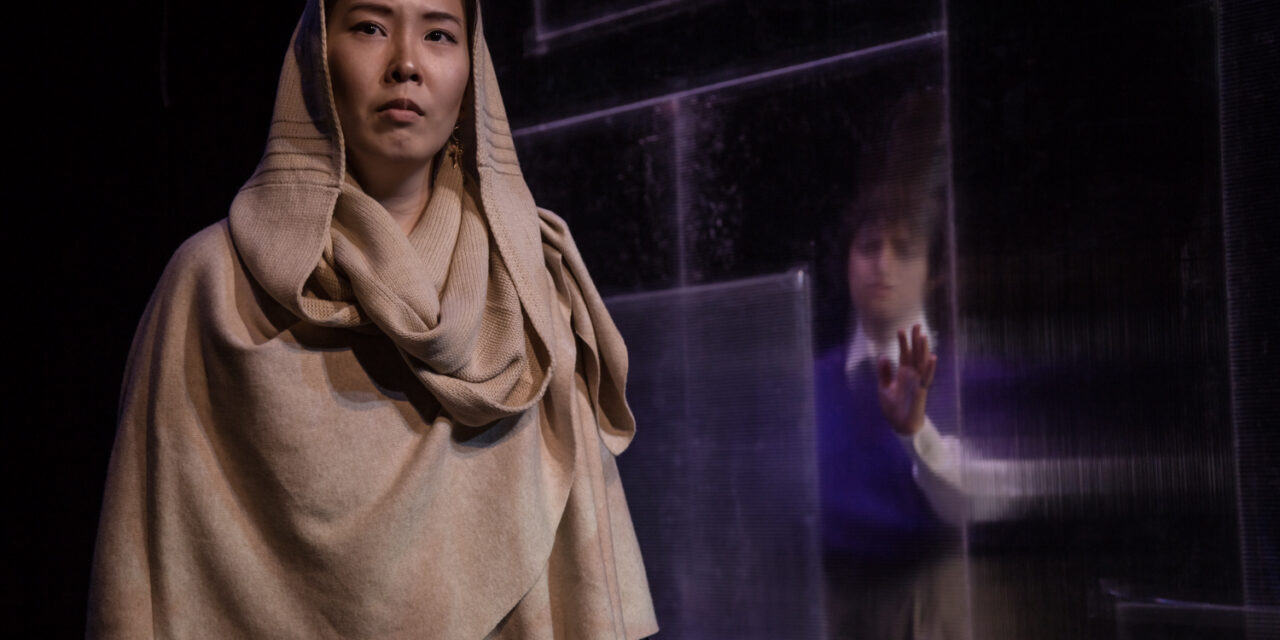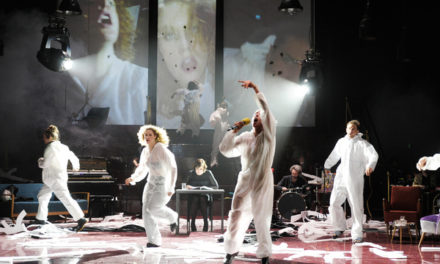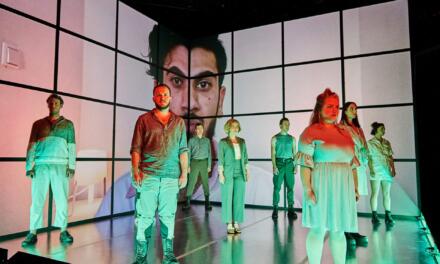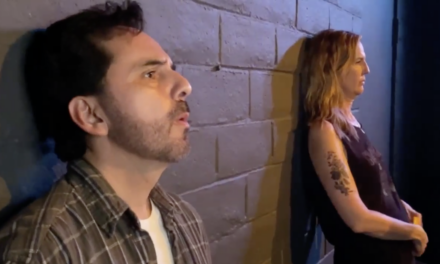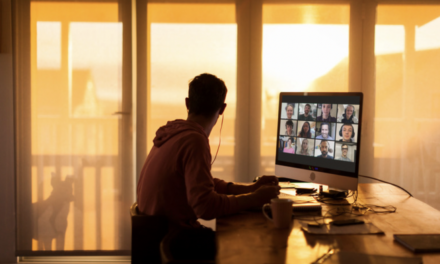When Rebecca Greene Udden graduated from Rice University, she decided to make Houston her permanent home and sow the seeds for a woman-centered theatre movement in Texas’ largest city. In 1975, Udden founded Main Street Theater, which has become a mainstay and leader in the Houston theatre community in the time since. For nearly five decades, Main Street has foregrounded stories by women playwrights, filling a void that is all-too-common, even in 2021. One of those playwrights who has been a part of this legacy is Caridad Svich. In 2009, Main Street produced the English-language premiere of Caridad Svich’s The House of the Spirits, based on the novel by Isabel Allende. In the time since, Main Street has maintained its relationship with Svich, who in 2012 won the prestigious OBIE Award for Lifetime Achievement. Now, in 2021, Main Street is set to produce another Caridad Svich premiere, albeit one far different than anything we could have imagined a year ago.
Main Street Theater presents the digital premiere of The Book of Magdalene under the direction of Amelia Rico. The play is a fully-staged production, filmed at Main Street’s Rice Village theatre. The Book of Magdalene will be available to stream online from February 11-21.
The Book of Magdalene takes place in the edge-lands in the aftermath of a worldwide catastrophic event. The play examines the spiritual concept of grace and it exists in the contemporary world. The play’s characters are haunted by all they have dealt with–de-industrialization, alienation, dis-harmony with the environment, and the effects of late-stage capitalism. The titular Magdalene, an outsider in several senses, must imagine a way to move forward despite the difficulties she faces. She seeks emotional connections to nourish her spirit, which can possibly extend to those around her. The Book of Magdalene is a play about finding the courage to move on, even when it feels impossible to do so.
In a unique twist brought on by the Covid-19 pandemic, Main Street will be able to serve its Houston audiences while also drawing from an international audience to witness this new play by an internationally-acclaimed playwright. Indeed in the age of streaming theatre, audiences can be in Houston and view live theatre from across the world in one weekend. Although most of us miss the days of crowding together in a dark theatre, the possibilities of digital theatre are exciting, breaking open the idea of what a play can be and who it can serve.
In this interview, Caridad Svich discusses The Book of Magdalene, working with Main Street Theater, making theatre during the Covid-19 pandemic, and the possibility of a new Federal Theatre Project.
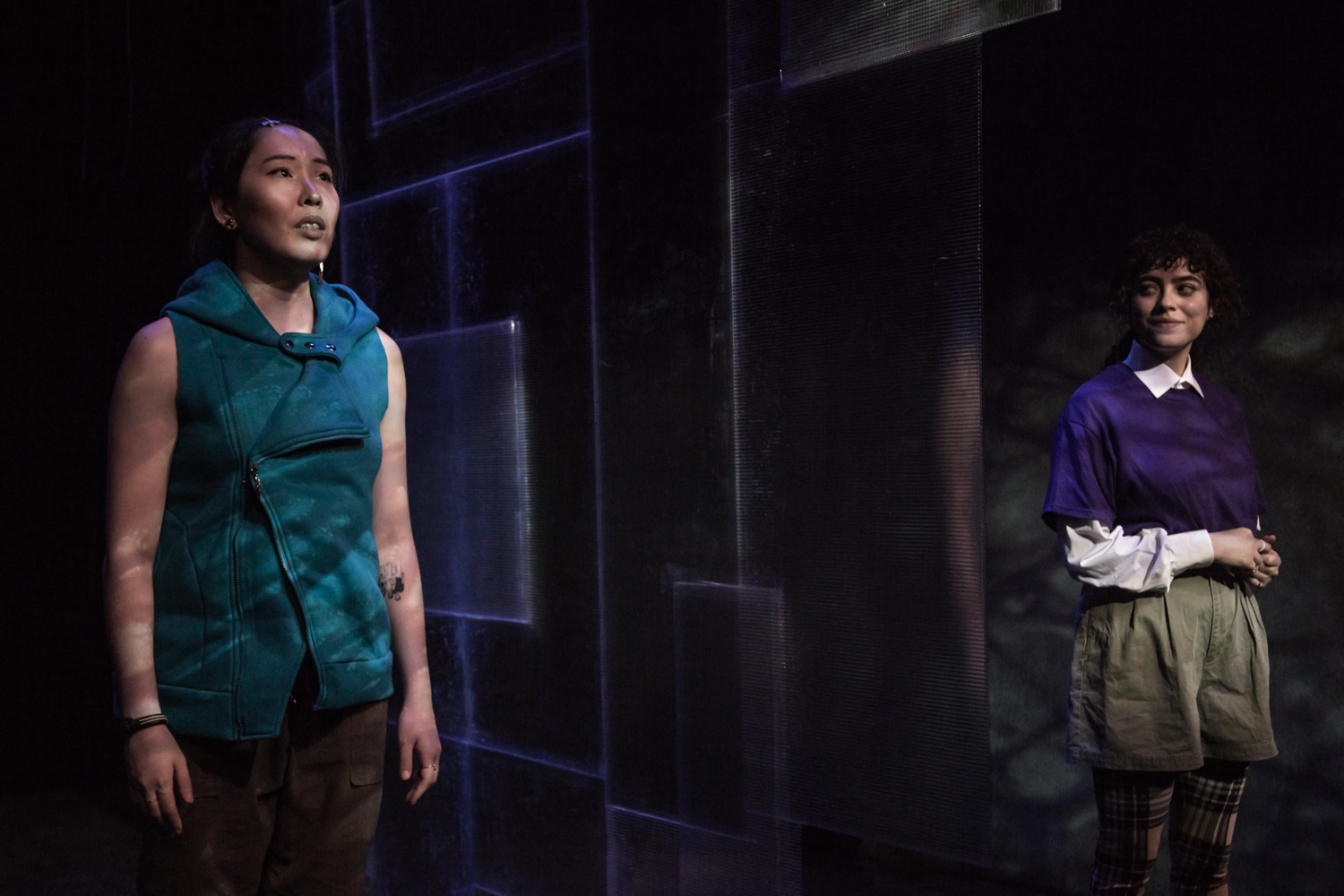
Jennifer Wang as Len & Mariam Albishah as Ru in The Book of Magdalene.” Photo by RicOrnelProductions.
Trevor Boffone: Can you tell us more about The Book of Magdalene? Why this play? Why now?
Caridad Svich: I started taking notes for the play late in 2019, partly in response to fka twigs’ album Magdalene. I had always been interested in Mary Magdalene as a historical figure, and also how throughout centuries she has been misrepresented. The original Mary Magdalene was wealthy and a patron, as it were, of and for Jesus’ cause. Somehow over time and through acts of narrativity, she becomes Mary Magdalene, the prostitute that serves as the mirror image to the Virgin Mary—the whore and the madonna paradigm that has bedevilled the representation of female-identifying bodies in the world and in art. As I started to work on the play in earnest, the first lockdown hit in March 2020. Needless to say, I was overwhelmed. And daunted and disoriented. But by that time the play was already taking the shape you will see now: a play set in a future now (haunted by these times) about a young sex worker who is going through a breakup with a romantic partner, is caring for their guardian, and is finding through way again in an eerie and cold world.
A lot, though not all, of my work is centered on loneliness and specifically the increasing dis-connection of neoliberal, capitalist societies (and mindsets) to the natural world, especially at a time when the spectre of climate change is not a mere phantom but a concrete reality. I am also always interested in the concept of grace in a spiritual sense. So, this play essentially centers on how people can re-connect to the natural world and to each other during atomized, splintered socio-political times and one character’s journey toward grace.
Why now? That’s always the question, isn’t it, when you make art. Best to look at the question this way, though: at a time of disconnect, stories about the need to connect feel urgent, even if the plot is not ripped from the headlines but is its own thing. Moreover, as a writer, there is the matter of my ongoing mission: in a sense the play initiates a break in my writing, working with themes to which I am usually attracted, but spinning them in a very different way linguistically. The “why now?” also has to do with where I am as a writer and how the play sits in relationship to my body of work.
Trevor: How does The Book of Magdalene fit within your larger body of work?
Caridad: And here’s your question! You are reading my mind! Well, I have articulated some of this in the prior question, but to go a bit deeper into this I would say that this play is the start of a new phase of my writing, one that had been building since I wrote Red Bike. Whereas the eight plays that comprise the American Psalm cycle that began with Red Bike, are focused on stories of the dispossessed in the US living in small, rural, and/or coastal communities struggling with the effects of post-industrialization, climate change, late capitalism, environmental and structural racism, starting with this play I am writing pieces that are set in cities, ravaged by some of the same issues, but dealing much more with what I call the “splinter effect” of them on the soul and on language—figuratively, on how people communicate with one another. I’m looking at how the brutalities of contemporary existence, sometimes cushioned or falsely veiled in the languages and apparatus of consumer and digital media culture, generate fissures (and also inventions) in speech acts, and in assessing/apprehending “the real.”
The Book of Magdalene sits at the beginning, then, of a new journey in my writing but also perhaps a synthesis and distillation of a majority of my body of work that has long been fusing what I like to call the acoustic (bare, stripped-down, land-based and water-based works) and electric (heavily mediated, hyperlinked, restless pieces) sides of my writing voice.
Trevor: What has it been like working with Main Street? How has your play grown since the process began?
Caridad: The process with Main Street has been great: fast and furious. I mean, every time a brand new play gets put on its feet, there’s a learning curve for everyone involved. The nature of this piece—its openness on the page but also in terms of casting—means that every version of it in production (if we get there) will be radically different. This is something I have been experimenting within a number of my plays since about 2013, and most recently with Red Bike. The evolution has more to do with interpretation, nuance and texture more than anything else in this staging. Plus, we are also dealing with the fact that it is a hybrid of theatre and film or what I like to call “plims.” Finding out what the tone and style of the piece is crucial in this process.
Trevor: Like many playwrights, 2020 derailed many of the projects you had been working on. You had 8 productions and several visiting lecturer gigs cancelled or postponed last year. Yet, in 2021 we are seeing theatres increasingly move toward producing high-quality streaming content. What does it mean for you to be working with Main Street on the digital premiere of a new play?
Caridad: Well, I have been banging the drum for digital theatre since the year 2000. I have always said that it is the future. And here we are. This does not mean that I disavow live, in-person theatre, but rather that I think digital theatre by its very hybridity can challenge existing modes of presentation and ways of seeing and thinking about theatre. It’s interesting that there’s a debate right now about whether digital/new media theatre is theatre or isn’t. If the intention of the makers is theatre, then it’s theatre. Plays are structured differently than other kinds of dramatic and live art. So, for example, when I write a screenplay, I don’t think to myself “oh, I am really making a piece of theatre.” I know I’m writing a film. What the field needs to reckon with and understand, if it hasn’t already, is that the intentionality of a project makes the difference.
Also, I think digital theatre (I first heard the term when the web platform Digital Theatre Plus launched many years ago in the UK) allows audiences from all over the world to see and hear work that they would otherwise not be able to see for reasons of geography, affordability, physical access and so on. The fact that suddenly an audience for a show in Houston with Houston-based creatives can be experienced by an audience in Brussels or Buenos Aires or Poughkeepsie is thrilling! I think digital theatre de-centers the primacy (real estate and media-wise) of theatre “centers” like London, New York, Chicago, and Berlin. It breaks the lock that these vibrant theatre capitals have had on many imaginations and says “look, theatre can and does happen everywhere, and look, there are amazing people making work all over.”
I do think the field is both at a crossroads and at a moment of profound evolution. And while digital theatre doesn’t solve everything, and reliable affordable wifi access is not in everyone’s hands (yet), I still think it makes the form much more accessible. Like Playhouse 90 did in the 1950s when they broadcast plays on TV, for example. The language of theatre, which is unique, suddenly is not “over there” for only a few, but to everyone that might be curious to engage with it. The effects of the pandemic are going to be with us for a long time, and scientists predict there will be more pandemics (because of climate change). So, the form has to grow and adapt. The means of production changes, and we’re all in the experiment together!
What I think the next step is—and I am experimenting with luckily—are multiple productions of the same play—what would normally be second, third and fourth productions, etc.—occurring at the same time. Red Bike, for instance, has had various digital versions, and soon opens at Unicorn Theatre in Kansas City in yet another. The ability to see the same text re-interpreted by different companies and creative teams is thrilling. But moreover, from a pedagogical perspective, how cool is it for students to see that plays can be staged, even digitally, in radically different ways. I know it won’t happen, but wouldn’t it be cool now that we have the digital version of Hamilton preserved forever to see a new director and team take that piece on in a very different way? Using some of the same tools, if not budget (eek) that Kail and company did? What a learning experience that would be. One that does happen when plays get done across the country, but not as readily seen side by side.
Trevor: Much of your work, from The Booth Variations to Iphigenia Crash Land Falls, has integrated multimedia into the theatrical realm. How do you view the marriage between theatre and the digital?
Caridad: It’s a tricky balance. I always say, to paraphrase my colleague, pioneer John Jesurun, “you can’t write plays in the 20th and 21st century pretending as if jazz, post-modernism, performance art, abstract art, hip-hop, minimalism and other new forms don’t exist.” Writers make work within a historical stream and continuum. Sometimes writers look backwards and adopt older forms to tell a story. Sometimes they are conscious that they are working within existing cultural modes. I mean, Brecht and Piscator were doing multimedia work. That was a long time ago. To me, it has to do with how the mediation part of the narrative and vocabulary of the play, just like a set or a costume or a prop. You look at function. It’s not about imposing or sticking media in to make something “cool” or whatever, it’s about being organic and responding to the needs of the piece that you are making and what will make it most effective. I’m interested in how live bodies interact with filmed bodies/faces/objects. It’s a layering effect. There are opportunities for counterpoint that are exciting. With something filmed, it always enters the realm of memory because the performer will always be in the past (unless it is live feed) in relationship to anything that is occurring live. A fascinating tension occurs, then, that one can play with dramaturgically from a hauntological perspective. Also, there’s the matter of scale and depth and rendering of a visual image (projection or video) next to something live. You can play with that and affect perception. In theatre, to quote the late Howard Stein, “you are always dealing with perception shifts.” The audience is always being re-oriented to the piece as the piece is happening. Aural and Visual Mediation (whether it be amplification of the voice, lip-synch, looping, glitch and ghosting effects, or working with black and white or color stock or cropping of the visual frame) is a tool that can illuminate the layers of a piece. But not as a gimmick. Only if central to what the piece is about and is pursuing conceptually.
Trevor: The Book of Magdelene premieres almost a full year after the Covid-19 pandemic forced theatre spaces to go dark. Since then, we have seen theatre-makers both embrace and reject digital methods of making and presenting theatre. You’ve been quite vocal on social media about the need for digital practices. How do you see this moment? What do you hope theatre-makers take away from this post-pandemic (whenever that may be)?
Caridad: The pandemic stopped theatre in its tracks from its usual way of doing things—that is to say, for a lot of people. I want to acknowledge that there are and have been artists working in the realm of transmedia for a long time. But for a great majority of venue-based and non-venue based artists, an entire way of working—a method—was suddenly not possible. So, the move to older forms like audio drama or experimenting with digital theatre is a means of survival. Literally. The other thing that has happened is that this “moment” has perhaps allowed more DIY work to occur bypassing gatekeepers. It’s not easy because there’s no funding, and I think the big question right now is how to monetize the work so that artists can break even or make something. If we didn’t live in capitalism, and having money didn’t affect housing, food, healthcare, etc., perhaps the question would be different. But because we do live in capitalism and every single organ of society is bounded by its principles at every level, then yes, we need to think about how artists can survive while also responding to the historical moment by witnessing it. I just put together a book of interviews for Methuen Drama called Toward a Future Theatre: Conversations During a Pandemic, which will be released, if all goes well, late summer 2021, and much of the discussions in the book are about what post-pandemic theatre will/might be. Not only is the field dealing with fiscal instability but also a reckoning with structural racism, gender inequality, ageism and ableism, and severe wealth gap issues. All in the middle of massive accelerating climate change. So, a post-pandemic theatre needs to rebuild and repair. A lot. And it will take a long time.
Trevor: Speaking of the pandemic, theatre in the United States have been met with silence from federal leadership in regards to a substantial bailout for the arts, all the while other industries have been given widespread government assistance. Some theatre-makers, including yourself, have taken to Twitter to advocate for a federal response, with some artists calling for a new Federal Theatre Project. What is your vision for a new Federal Theatre Project?
Caridad: The fact that unlike other countries the arts in the US are not subsidized is absurd. It speaks to some of the broken-ness at the heart of a country when it does not recognize art as necessary to the health of a nation and its social fabric. A new Federal Theatre Project would be amazing to put into effect, though if we look at the FTP when it first occurred in the US, you will see how it didn’t last long because content that artists wanted to make started to be at odds with what the federal government was willing to fund. Nonetheless, I think the first thing that needs to happen—and not just on TikTok (as lovely as a lot of the creative work is on that platform)—is an integration of arts and society and by that I mean that art not be seen as this “other thing that happens once a week or once a month or once a year on Broadway or whatever” but a part of daily life. And I know for some communities this is not an issue, because arts (music, dancing, singing, writing, design, etc) are already valued. But for a lot of them it is not. The slashing of arts budgets in educational institutions (at primary, middle and high schools) over the last fifteen years has obviously been detrimental and has further pushed the arts and the viability of a career and life in the arts into the margins.
So, art desks, art check-ins, for instance, is something I imagine. What if in the middle of the workday, there were art check-ins—whether through viewing art or talking with artists or making things together—as a way to simply offer spaces of virtual or physical gathering and contemplation. Not everything has to be vocal. There is something beautiful about just being with art for a while. Like walking through or seeing a public art piece. Hire muralists. Hire architects and designers to make things. Interact with the physical and digital environments within and around communities. Set up art kiosks. There’s one in Boston at a shopping center that I love which is a kiosk where you can print a small, very small book, randomly chosen by you and its short enough to read during your time in the mall, but it’s a rotating series of specially crafted unique art pieces (on scrolls of paper) that make you re-think where you are in the city and how you interact with it.
Obviously, there are more active ways of hiring artists—as second responders, food bank workers and so on. But these are just some ideas. To my mind, what would happen if the FTP turned in Universal Basic Income for Artists, which cities like Long Beach and San Francisco are already adopting? What happens when artists are not just part of a rapid response project but sustained to do the cultural labour of society and chase their visions of the future in a manner that levels the playing field of who can “afford” to be an artist and who cannot?
This post was written by the author in their personal capacity.The opinions expressed in this article are the author’s own and do not reflect the view of The Theatre Times, their staff or collaborators.
This post was written by Trevor Boffone.
The views expressed here belong to the author and do not necessarily reflect our views and opinions.

